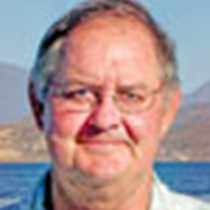Bahia Magdalena, Boca de Soledad
A day’s activities really start the night before. We have a late afternoon talk on grey whales by Lee, update briefings by Sue and an after-dinner talk by Carlos on the history of Magdalena Bay. During our afternoon social hour we watch live plankton on the video-microscope project – tiny organisms on which the marine life we are here to see ultimately depends. We go to bed with an appreciation of food webs and a good idea of what the next day will bring – grey whales, ballena gris. On the way to our cabins, a few of us notice a mild wind. It rocks us to sleep.
Morning brings whitecaps and a growing swell, products of the increasing wind off the Pacific into Boca de Soledad. These conditions do not deter our intrepid explorers. The first group of whale watchers departs after breakfast and comes back with jackets dampened, but not enthusiasm. There are many whales nearby.
We are off in the Zodiac at 10:48 a.m. through the wind-chop: two minutes later we see a pair of whales spy-hopping ahead. We are about 500 meters from the National Geographic Sea Bird. Two minutes later two spouts appear in the same area and another spy-hop. Being a scientist, I decide to log the sightings and their times – I fear that my memory will not be accurate. 10:54 – two spouts 50 meters away. 10:55 – flukes at 40 m. 10:57 – spout at 30m. During the next two hours I record 81 sightings, including two breaches, six spy-hops, four underwater bubble-bursts, seven fluke showings, two head-pokes, and 60 spouts – 16 of which offered views that revealed the barnacle-encrusted backs and unique dorsal “knuckle” ridge. That equates to one sighting every 90 seconds. This strikes me as an amazing statistic.
At 12:30 a.m. we return to the National Geographic Sea Bird, which has graciously steamed down south for the two miles we have covered, sparing us the adventure of returning upwind through the white caps. They know how to take care of us.
Winds die down after lunch, and by the 4:00 p.m. Zodiac cruise it is warm with only a mild breeze. We race south a few miles to find ourselves in the middle of a whale playground, a Romper Room. Three mother-calf pairs are milling around together, rolling on their sides, showing half their flukes and poking heads out of the water. Many mysterious underwater bubble-bursts erupt. A mother occasionally guides her calf near a Zodiac, in a few cases right up to it. A sudden spout from a calf three feet off our port bow soaks the ship’s doctor – a whale facial that he has never before received. This amazing spectacle continues for a half hour, and during this time we hold absolutely steady in the tidal current. A motionless great blue heron on the nearby shore marks our spot. Time and space collapse; we are in the world of the whale. Statistics, photographs and even memory are unnecessary. These images are stored more deeply within us.




